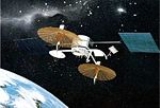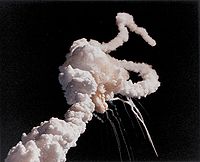
TDRS-B
Encyclopedia
TDRS-B was an American
communications satellite
, which was to have formed part of the Tracking and Data Relay Satellite System
. It was destroyed when the disintegrated
73 seconds after launch.
TDRS-B was launched in the payload bay of Challenger, attached to an Inertial Upper Stage
. It was to have been deployed from the Shuttle in low Earth orbit
. The IUS would have then performed two burns to raise the satellite into a geosynchronous orbit
. On the previous TDRS launch, TDRS-1
, the IUS second stage motor malfunctioned following the first stage burn, resulting in a loss of control, and delivery of the satellite into an incorrect orbit.
 TDRS-B was originally scheduled for launch on STS-12 in March 1984, however it was delayed and the flight cancelled following the IUS failure on TDRS-1. It was later re-manifested on STS-51-E, however this too was cancelled due to concerns over the reliability of the IUS. It was eventually assigned to STS-51-L
TDRS-B was originally scheduled for launch on STS-12 in March 1984, however it was delayed and the flight cancelled following the IUS failure on TDRS-1. It was later re-manifested on STS-51-E, however this too was cancelled due to concerns over the reliability of the IUS. It was eventually assigned to STS-51-L
, which was to also carry the SPARTAN-Halley astronomy satellite.
STS-51-L launched with TDRS-B at 16:38 GMT on 28 January 1986. The Shuttle disintegrated 73 seconds after launch
due to an o-ring
failure in one of the Solid Rocket Boosters
, killing the seven astronaut
s aboard.
_-_gpn-2004-00007.jpg) Once it reached orbit, TDRS-B was to have been given the operational designation TDRS-2. Although normal practice was to reassign operational designations in the event of launch failures, the TDRS-2 designation was not reassigned, and when TDRS-C was launched, it became TDRS-3
Once it reached orbit, TDRS-B was to have been given the operational designation TDRS-2. Although normal practice was to reassign operational designations in the event of launch failures, the TDRS-2 designation was not reassigned, and when TDRS-C was launched, it became TDRS-3
. Debris from TDRS-B was recovered along with the wreckage of Challenger
The TDRS-G satellite was ordered to replace TDRS-B. It was launched from in 1995, on mission STS-70
. It became TDRS-7
after reaching geosynchronous orbit.
United States
The United States of America is a federal constitutional republic comprising fifty states and a federal district...
communications satellite
Communications satellite
A communications satellite is an artificial satellite stationed in space for the purpose of telecommunications...
, which was to have formed part of the Tracking and Data Relay Satellite System
Tracking and Data Relay Satellite System
The Tracking and Data Relay Satellite System is a network of American communications satellites and ground stations used by NASA for space communications. The system was designed to replace an existing network of ground stations that had supported all of NASA's manned flight missions...
. It was destroyed when the disintegrated
Space Shuttle Challenger disaster
The Space Shuttle Challenger disaster occurred on January 28, 1986, when Space Shuttle Challenger broke apart 73 seconds into its flight, leading to the deaths of its seven crew members. The spacecraft disintegrated over the Atlantic Ocean, off the coast of central Florida at 11:38 am EST...
73 seconds after launch.
TDRS-B was launched in the payload bay of Challenger, attached to an Inertial Upper Stage
Inertial Upper Stage
The Inertial Upper Stage , originally known as the Interim Upper Stage, is a two-stage solid-fueled booster rocket developed by the U.S...
. It was to have been deployed from the Shuttle in low Earth orbit
Low Earth orbit
A low Earth orbit is generally defined as an orbit within the locus extending from the Earth’s surface up to an altitude of 2,000 km...
. The IUS would have then performed two burns to raise the satellite into a geosynchronous orbit
Geosynchronous orbit
A geosynchronous orbit is an orbit around the Earth with an orbital period that matches the Earth's sidereal rotation period...
. On the previous TDRS launch, TDRS-1
TDRS-1
TDRS-1, known before launch as TDRS-A, is an American communications satellite which is operated by NASA as part of the Tracking and Data Relay Satellite System. It was constructed by TRW and launched by on its maiden flight, STS-6. While on the pad, problems were detected with the Shuttle's main...
, the IUS second stage motor malfunctioned following the first stage burn, resulting in a loss of control, and delivery of the satellite into an incorrect orbit.
Launch

STS-51-L
STS-51-L was the twenty-fifth flight of the American Space Shuttle program, which marked the first time an ordinary civilian, schoolteacher Christa McAuliffe, had flown aboard the Space Shuttle. The mission used Space Shuttle Challenger, which lifted off from the Launch Complex 39-B on 28 January...
, which was to also carry the SPARTAN-Halley astronomy satellite.
STS-51-L launched with TDRS-B at 16:38 GMT on 28 January 1986. The Shuttle disintegrated 73 seconds after launch
Space Shuttle Challenger disaster
The Space Shuttle Challenger disaster occurred on January 28, 1986, when Space Shuttle Challenger broke apart 73 seconds into its flight, leading to the deaths of its seven crew members. The spacecraft disintegrated over the Atlantic Ocean, off the coast of central Florida at 11:38 am EST...
due to an o-ring
O-ring
An O-ring, also known as a packing, or a toric joint, is a mechanical gasket in the shape of a torus; it is a loop of elastomer with a disc-shaped cross-section, designed to be seated in a groove and compressed during assembly between two or more parts, creating a seal at the interface.The O-ring...
failure in one of the Solid Rocket Boosters
Space Shuttle Solid Rocket Booster
The Space Shuttle Solid Rocket Boosters were the pair of large solid rockets used by the United States' NASA Space Shuttle during the first two minutes of powered flight. Together they provided about 83% of liftoff thrust for the Space Shuttle. They were located on either side of the rusty or...
, killing the seven astronaut
Astronaut
An astronaut or cosmonaut is a person trained by a human spaceflight program to command, pilot, or serve as a crew member of a spacecraft....
s aboard.
Aftermath
_-_gpn-2004-00007.jpg)
TDRS-3
TDRS-3 , known before launch as TDRS-C, is an American communications satellite which is operated by NASA as part of the Tracking and Data Relay Satellite System...
. Debris from TDRS-B was recovered along with the wreckage of Challenger
The TDRS-G satellite was ordered to replace TDRS-B. It was launched from in 1995, on mission STS-70
STS-70
STS-70 was the 21st flight of the Space Shuttle Discovery, and the last of 7 shuttle missions to carry a Tracking and Data Relay Satellite . This was the first shuttle mission controlled from the new Mission Control Center room at the Johnson Space Center in Houston...
. It became TDRS-7
TDRS-7
TDRS-7, known before launch as TDRS-G, is an American communications satellite which is operated by NASA as part of the Tracking and Data Relay Satellite System. It was constructed by TRW as a replacement for TDRS-B, which had been lost in the Challenger accident, and was the last first-generation...
after reaching geosynchronous orbit.

